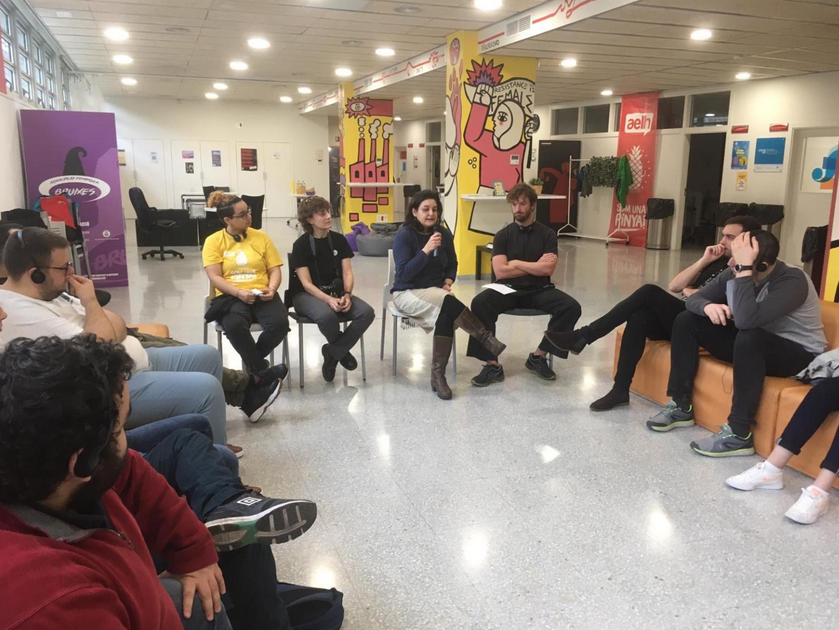 Paris, France, April 2020 – What role do alternative narratives play in preventing discrimination, polarisation and radicalisation at the local level? What do successful campaigns look like? What actors should be involved? The Efus-led LOUD project (Local Young Leaders for Inclusion) (January 2019 – January 2021) examined these and other questions during the first of a series of webinars that gathered over 50 participants online on 19 March.
Paris, France, April 2020 – What role do alternative narratives play in preventing discrimination, polarisation and radicalisation at the local level? What do successful campaigns look like? What actors should be involved? The Efus-led LOUD project (Local Young Leaders for Inclusion) (January 2019 – January 2021) examined these and other questions during the first of a series of webinars that gathered over 50 participants online on 19 March.
The webinar was presented by Maria Lozano of the European Union’s Radicalisation Awareness Network (RAN), who is expert for the LOUD project. Previously, she was an expert for the Efus-led Local Voices (“Local Communication Strategies to Prevent Extremism”) project.
> The importance of communicating locally
One of the key factors of the success of a campaign is its local aspect. “Extremists use a local approach when designing their campaigns, in particular because young people are more inclined to believe discourses they hear locally. Also, because this is what extremists do: they address local issues,” said Maria Lozano. “Alternative narratives must therefore have a local approach; they must have local content; they must address local vulnerabilities, and they count on local resilience factors. They also must use local voices. This local approach is applicable both off and online.”
In this respect, local authorities are particularly well placed to deliver impactful campaigns because they can design and produce them locally, based on their deep knowledge of the local context, local population, and relevant local actors. Local authorities have a key role to play in preventing phenomena of discrimination, polarisation and violent extremism, in particular through such local communication campaigns. Indeed, this is the purpose of the LOUD project.
> The four approaches to prevention and counter-narrative campaigning
1) Media literacy
This should not be seen as a project in itself but rather as part of “democracy training”. “The concept of critical thinking should be applied on a daily basis, in our daily life,” says Maria Lozano.
2) Garner the support of tech companies
The second approach consists in rallying tech companies so they do not support extremist content and remove them if need be. “We can take extremist contents offline using technology,” she says.
3) Empower alternative narratives
This third approach is related to the LOUD project and consists in empowering alternative narratives in order to promote positive messages such as universal values or role models. “This amounts to strengthening the immune system of society, the resilience of individuals and community.”
4) Using counter-narratives to expose extremist narratives and organisations
Also related to LOUD, this fourth approach seeks to expose extremist narratives and organisations. It requires targeting only well-researched, narrow audiences that have already been exposed to extremist contents, otherwise the campaign might not yield the expected results or worse, backfire.
> The Do No Harm principle…
The Do No Harm principle is a fundamental one that is applied in all sorts of fields apart from communication (research, medicine, etc.). It means that we must ensure our campaign does not produce any counter-effects or collateral damage, and thus be aware of what works and not.
… and other key success factors
The Do No Harm principle is a fundamental one that is applied in all sorts of fields apart from communication (research, medicine, etc.). It means that we must ensure our campaign does not produce any counter-effects or collateral damage, and thus be aware of what works and not.
> Be interactive and foster dialogue
In order to be impactful, the message(s) of the campaign must be conveyed in an interactive manner, i.e. the opposite of a top down approach. A good campaign should foster dialogue rather than preach.
When communicating online, there are certain pitfalls that must be avoided. One is to be too long and bury the message under too much irrelevant information (especially online where messages are short and people rarely read/watch them to the end). Another is to be invisible because the content is not updated frequently enough. A third is to use the wrong communication channel , i.e. is Facebook (or other platform) appropriate for a given message and audience, or would it be better to use Instagram (or other platform)?
> The crucial role of evaluation
Evaluation is crucial throughout, from the design of the campaign to its implementation and its impact. “You should include evaluation as early as in the planning stage in order to adjust the campaign and activities when necessary, and after that evaluate the impact of the campaign,” says Maria Lozano. She recommends associating representatives of the target audience(s) to the evaluation at all stages. (Note: we will go back to the crucial topic of evaluation in our fourth and last LOUD webinar in June, see date below).
> Involving local stakeholders
Local authorities are strongly encouraged to involve civil society organisations (CSOs), communities and members of the target group at all stages of their local communication campaign, including the evaluation.
Such involvement of local stakeholders gives credibility to the campaign. This is all the more important that prevention programmes and communication campaigns run by local authorities do not always have the desired credibility with their target. It also enables local authorities to work with local CSOs’ own networks.
Maria Lozano strongly recommends involving these local stakeholders in the assessment of the campaign throughout its different phases. This will enable the campaign organisers to eventually adapt the content or broadcast channel according to the feedback they receive.
> More information on LOUD
> Watch the (recorded) webinar
> LOUD’s three next webinars will be broadcast on 22 April, 20 May, and on 24 June. To register (free of charge), see the LOUD web page (same as above).




